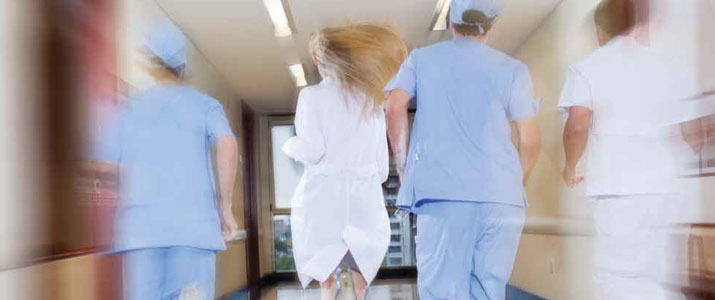
Critical to Healthcare Security
IP network surveillance is an essential component on a hospital campus
- By Greg Peratt
- May 01, 2014
 Ensuring the safety and security of patients and employees is critical
to healthcare organizations of any size. For larger facilities, the task
can seem monumental, leading many in the industry to turn to IP
network surveillance technology to help take control of the process.
Ensuring the safety and security of patients and employees is critical
to healthcare organizations of any size. For larger facilities, the task
can seem monumental, leading many in the industry to turn to IP
network surveillance technology to help take control of the process.
IP network surveillance systems can greatly impact the way a
hospital is operated. Security staff can monitor and record video from the most
sensitive areas on campus such as surgery rooms, ERs, psych wards and unmanned
parking lots. Additionally, the high-definition imagery provided by today’s IP network
systems benefit organizations in a range of areas beyond protecting people
and assets, including: improving operational efficiency, resolving employee disputes
and preventing dishonest lawsuits.
In fact, the video surveillance market, which had been fairly flat for years, has
recently seen significant growth, with healthcare being one of the leading segments.
According to IMS Research, the total market for video surveillance equipment in
the Americas is estimated to grow to $5.7 billion in 2015. That’s nearly double the
figure reached in 2011.
The Rise of IP Network Surveillance Technology
An increased shift to HD network video products is contributing to this growth.
By 2015, more than 70 percent of all network camera shipments will be megapixel
resolution. For the healthcare industry, the move to high-definition, IP surveillance
systems allows hospitals to leverage the power of the facility’s IT network to
correlate information from traditionally separate subsystems, such as video surveillance
and analytics. This can increase situational awareness and help security
staff identify threats or misconduct before an event occurs. It also allows hospital
management to improve operations from a business perspective.
IP surveillance systems deliver powerful, high-definition video with greater
clarity than traditional CCTV systems. A typical IP surveillance system consists of
multiple cameras connected to video storage servers that record and process video
streams, and an operations center or hub, where video is displayed and monitored
on a real-time basis. IP security cameras can be used nearly anywhere on a hospital
campus: on streets and building exteriors, inside buildings, hallways and parking
lots, and so on. There are many types of fixed or adjustable cameras suited for
many applications. To support the IP video network, and enable remote camera
control and operation, a high-speed IP/Ethernet network is required.
Many hospitals have installed robust network infrastructures in recent years,
making them well suited for IP-based video systems. These facilities are currently
moving large information packets across their networks, such as MRIs
and ultrasounds.
Key Benefits of IP-Based Systems
The use of advanced networking technology and HD-quality cameras has changed
the face of the security industry. The ability to access remarkably crisp images,
either from a command center or remotely, is helping to improve preventive monitoring,
increase staff productivity and raise the evidentiary value of surveillance
footage by HR departments as well as in the courtroom.
Centralization and remote access monitoring. Providing effective video surveillance
over an entire hospital campus is a daunting task. With a centralized command
center, security staff can monitor live events from multiple cameras while
simultaneously reviewing recorded footage from specific incidents.
Additionally, a video surveillance system operating with IP network technology
enables cameras throughout the campus to be viewed online via an Internet connection.
Where security officers were once tied to a desk, mobile computers and
wireless tablets enable remote access of video footage, allowing personnel to move
freely across hospital sites as needed to best perform their jobs.
Digital storage. With an IP-based system, the user is able to digitally store recorded
footage on network servers or video recorders. This stored video is easily
accessible to authorized users and offers improved search capabilities.
HD imaging. Megapixel IP cameras capture a wider field-of-view (FOV) than
analog cameras while delivering crystal-clear, HD images that preserve even the
smallest details. This means fewer cameras and increased surveillance coverage.
Digital zoom features allow staff to maintain a wide frame for total coverage,
while providing the ability to drill down to specific points of interest to obtain
granular details. HD images enable security professionals to capture facial features,
tiny lettering and numbering, and other critical details that could not have
been captured before.
Privacy. Complicating video surveillance at hospitals are patient privacy considerations
mandated by the Health Insurance Portability and Accountability
Act (HIPPA). Aiding with this cause are new camera capabilities, such as enhanced
privacy masking. With this type of technology the door to a patient’s
room or other visible personal data in a camera’s image can be masked to ensure
patient privacy.
Video analytics. High-definition video and analytics are helping organizations
to improve business processes, in addition to protecting their people and assets.
Powerful, digital, video analytics tools turn surveillance systems into a proactive
watchdog.
Traditional analog CCTV systems provide a recording of historical events
that are captured on a DVR and can be analyzed after events have occurred.
With powerful analytics software, an IP security system can be programmed to
provide alerts to specific events in real time. Triggers can be set to notify personnel
about potential threats or other concerns, such as overcrowded parking lots
or lobby areas.
With security cameras, hospital management can monitor campus activity,
ensuring that hospital policies are properly followed.
Hospital Usage Best Practices
A hospital is like a city that never sleeps. The safety of patients, visitors and staff, as well as the protection of valuable assets, all require constant attention. With
the proper video system, security staff can continuously monitor cameras that
overlook entries, lobbies, corridors and emergency departments as well as external
areas, like parking lots.
Operators can watch for troubled patients, monitor suspicious behavior and
watch for unauthorized visitors in restricted areas. Cameras can also serve as a visual
deterrent to crime such as theft, break-ins and vandalism to hospital property.
Conflict resolution, patient claims and employee issues. Video can be useful
in monitoring patient and visitor-related incidents, including slip-and-fall cases.
There have been a number of claimed injuries that were not supported by recorded
video. In these instances, the claims were either withdrawn or rejected. This type of
visual evidence can save the hospital from pricey, unwarranted insurance claims.
Surveillance cameras can provide invaluable visual evidence for investigations
of criminal activity and other events that have taken place within or around healthcare
facilities. For internal purposes, employee disputes can be easily resolved when
clear, visual proof is available to shed light on the incident in question.
Drug diversion. Strategically placed video surveillance cameras can help deter
drug diversion—a problem faced by many hospitals. Drugs can go missing from a
number of areas including main pharmacies, satellite pharmacies, dispensing areas
on the hospital floor and loading docks. Video can help security identify staff that
diverts drugs for personal use, and analytics software can be used to detect loitering,
if an individual remains in a drug-dispensing area or adjacent area longer
than a specified time.
Emergency departments. One of the greatest areas of vulnerability is a hospital’s
emergency department (ED) where most incidents of violence occur. Risk
occurrences often arise when large groups crowd the lobby to wait for news about
friends or family. Video and analytics software can be used to count the number
of people who enter and exit, and alert security personnel when crowds exceed a
defined size.
With crowded EDs, there is also risk that busy personnel might not notice when
a patient loses consciousness in the waiting room or when an admitted patient has
not been checked at the required frequency. Hospitals can use analytics software
to detect when these patients cross a specified threshold, and then send an alert or
implement another plan of action.
Infant tracking. Many hospitals are using wrist or ankle bracelets with an embedded
radio that issues an alert if an infant is moved outside of a specified area.
Although this type of system provides early awareness of possible abduction, hospital
staff may not be aware of what the abductor looks like and could allow the
person to pass through a door with the baby hidden. With video surveillance cameras
in nurseries and other areas, hospitals can capture the suspected abductor’s
image to include with the alert. Staff can view the image on desktops, smartphones
and digital signs throughout the hospital.
Hospitals face the unique challenge of balancing security and safety with the
mission of providing care and services in an open and welcoming environment.
Through advanced, network-based, HD surveillance systems, hospitals today can
be armed with technology that allows staff members to have the
information they need to be safe, while focusing on their mission
of providing excellent care.
This article originally appeared in the May 2014 issue of Security Today.